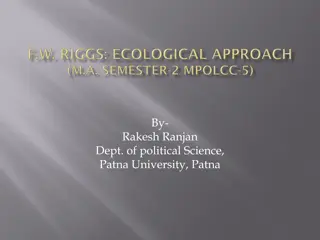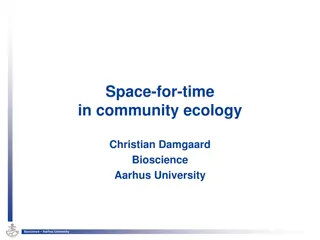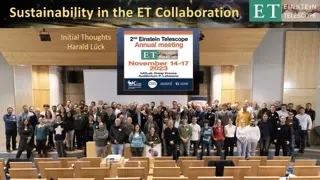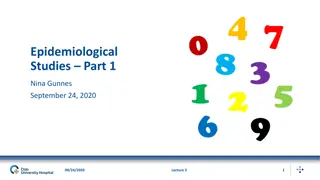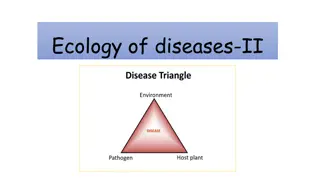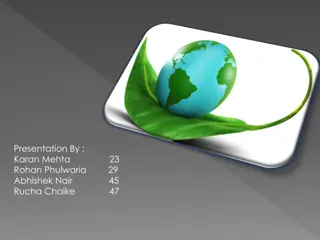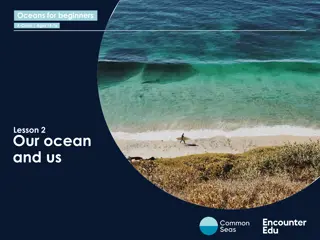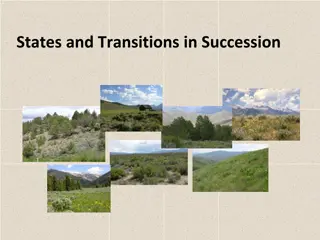Understanding Biological Diversity and Ecological Organization
Exploring the intricate balance of flora and fauna on our planet, this content delves into the vast array of plant and animal species coexisting in various ecosystems. It discusses the significance of biodiversity, the interaction of biotic and abiotic components in ecological systems, and the ecological organization from individual organisms to entire ecosystems. Additionally, it touches upon the delicate balance of physiological ecology and conservation efforts essential for maintaining the harmony of nature.
- Biological Diversity
- Ecological Organization
- Biodiversity Conservation
- Flora and Fauna
- Ecosystem Interaction
Download Presentation

Please find below an Image/Link to download the presentation.
The content on the website is provided AS IS for your information and personal use only. It may not be sold, licensed, or shared on other websites without obtaining consent from the author. Download presentation by click this link. If you encounter any issues during the download, it is possible that the publisher has removed the file from their server.
E N D
Presentation Transcript
OUR MOTHER EARTH, The Nature Biological Diversity Ecosystem Pollution and its effects
Biological Diversity of the World Biological Diversity of Indian Subcontinents Flora and Fauna Angiosperms Gymnosperms Pteridophyta Bryophyte Lichens Algae Fungus Mammals Birds Reptiles Amphibians Fishes Arthropods Molluscs Protozoans Others Flora and Fauna Number of 17,500 Number of Sps Sps. . Flora and Fauna plants Algae Fungus Cyanobacteria Mammals Angiosperm Birds Reptiles Fishes Amphibians Insects Arthropods Molluscs Helminthes Protozoans Others Source: FSI Flora and Fauna Number of 2,70,000 40,000 72,000 4,000 4,650 9,700 Number of Sps Sps. . 64 1,100 2,850 2,000 6,500 14,500 300 1,232 456 209 2,546 68,389 5,070 2,577 8,329 7,150 26,959 4,780 10,25,000 43,000 70,000 25,000 40,000 1,10,000 Source: FSI(2009)
Biodiversity = Flora + Fauna i.e. Plants and Animals together ( BIOTIC COMPONENTS OF ECOSYSTEM) General Ecology General Ecology ECOLOGY another and with their environment ENVIRONMENT components ABIOTIC physical factors as soil, rainfall, sunlight, temperatures BIOTIC organisms ECOLOGY how organisms interact with one another and with their environment ENVIRONMENT living and non components ABIOTIC non physical factors as soil, rainfall, sunlight, temperatures BIOTIC living component are other organisms how organisms interact with one living and non- -living living non- -living component or living component or living component are other
ECOLOGICAL ORGANIZATION INDIVIDUAL POPULATION species in same area (biotic factors) COMMUNITY same area (biotic factors) ECOSYSTEM factors BIOSPHERE ECOLOGICAL ORGANIZATION INDIVIDUAL individual organisms POPULATION organisms of same species in same area (biotic factors) COMMUNITY several populations in same area (biotic factors) ECOSYSTEM community plus factors BIOSPHERE all ecosystems on earth individual organisms organisms of same several populations in community plus abiotic abiotic all ecosystems on earth Forest, Forest, Marine Marine
ECOLOGY OF INDIVIDUALS Homeostasis Components Physiological Ecology Temperature and Water Balance Light and Biological Cycles Physiological Ecology and Conservation ECOLOGY OF INDIVIDUALS Homeostasis delicate balance Components Physiological Ecology Temperature and Water Balance Light and Biological Cycles Physiological Ecology and Conservation delicate balance
Environmental Problems Environmental Problems A. Aquatic Environment Issues Water Diversion, Overfishing B. Air Quality Issues Nuclear Pollution C. Climate Change Issues Ozone Depletion D. Terrestrial Environment Issues Soil pollution, Waste Disposal, Mining E. Population Growth Issues Farming Practices, Fertilizers & Pesticides A. Aquatic Environment Issues Water pollution, Water Diversion, Overfishing B. Air Quality Issues Acid rain, Air Pollution, Nuclear Pollution C. Climate Change Issues Greenhouse Effect, Ozone Depletion D. Terrestrial Environment Issues Deforestation, Soil pollution, Waste Disposal, Mining E. Population Growth Issues Habitat Destruction, Farming Practices, Fertilizers & Pesticides Water pollution, Acid rain, Air Pollution, Greenhouse Effect, Deforestation, Habitat Destruction,
Pollution Definition: Any undesirable change in the environment caused by Human Activities
Environmental Pollution Environmental Pollution Air Pollution Water Pollution Soil Pollution Noise Pollution Radioactive Pollution Thermal Pollution Air Pollution Water Pollution Soil Pollution Noise Pollution Radioactive Pollution Thermal Pollution
Aquatic Environmental Issues Water pollution Eutrophication Ocean Dead Zones Thermal Pollution Overfishing Aquatic Environmental Issues Water pollution Eutrophication Ocean Dead Zones Thermal Pollution Overfishing
Eutrophication Eutrophication nutrients. This can be a problem in marine habitats such as lakes as it run increase in It causes rapidly, resulting in This bloom of algae and causes many problems. The algae may use up none for other marine life. This aquatic organisms such as fish, which need the water to live. The bloom of algae photosynthetic marine plants under the water Some algae even forms of life. This can cause and affect any animal that feeds on them. Eutrophication Eutrophication bodies of water becomes enriched nutrients. This can be a problem in marine habitats such as lakes as it can cause algal blooms. run- -off from fertilizers, into nearby water increase in nutrient levels It causes phytoplankton to grow and reproduce more rapidly, resulting in algal This bloom of algae disrupts normal ecosystem functioning and causes many problems. The algae may use up all the none for other marine life. This results in the death of many aquatic organisms such as fish, which need the oxygen in the water to live. The bloom of algae may also photosynthetic marine plants under the water surface. Some algae even produce toxins that are harmful to higher forms of life. This can cause problems along the food chain and affect any animal that feeds on them. bodies of water becomes enriched with with can cause algal blooms. off from fertilizers, into nearby water causing an nutrient levels. . phytoplankton to grow and reproduce more algal blooms disrupts normal ecosystem functioning causing an blooms. . all the oxygen oxygen in the water, leaving results in the death of many the oxygen in in the water, leaving may also block sunlight block sunlight from from surface. produce toxins that are harmful to higher problems along the food chain
Climate Change Issues Climate Change Issues Greenhouse Effect results when the atmosphere traps heat radiating from Earth toward space. Ozone Depletion deteriorating due to the release of pollution containing the chemicals chlorine and bromine (chlorofluorocarbons or CFCs) Greenhouse Effect - - warming that results when the atmosphere traps heat radiating from Earth toward space. Ozone Depletion - - ozone layer is deteriorating due to the release of pollution containing the chemicals chlorine and bromine (chlorofluorocarbons or CFCs) warming that ozone layer is
Ozone Depletion Ozone Depletion
Greenhouse Effect Greenhouse Effect
Fertilizers and Pesticides Fertilizers and Pesticides
Nonrenewable vs. Renewable Energy Sources Non as coal, oil and natural gas as well as nuclear fuels and have negative environmental impacts Renewable energy sources waves, heat, hydropower and biomass that can be used again and again and is energy sources. There are pros and cons for each type of energy Nonrenewable vs. Renewable Energy Sources Non- -renewable energy sources as coal, oil and natural gas as well as nuclear fuels limited supply will run out and have negative environmental impacts Renewable energy sources sun, wind, waves, heat, hydropower and biomass that can be used again and again and is cleanest energy sources. There are pros and cons for each type of energy renewable energy sources fossil fuels fossil fuels limited supply will run out sun, wind, cleanest
Man affects his Environment through the change of: Land Use Land Use & &
Deforestation Effects on Environment : atmospheric carbon dioxide concentration increases soil erosion by heavy rain or strong wind no root to hold soil particles together soil being washed into rivers fills up the river bed causes flooding
Deforestation Effects on Environment : destroys natural habitats & causes loss of species cause extinction of species because of destruction of natural habitat loss of important medicines
Monoculture Effects on Environment : increase in pest population monoculture enables pests to have continual supply of food exhaustion of particular type of minerals the same type of plants draws particular types of mineral from the soil for a long time
Pollutants Smoke & Exhaust Fumes Domestic Wastes Agricultural Wastes Industrial Wastes Noise
Effect of Pollutants on Human Health & the Environment
Smoke & Exhaust Fumes Carbon Monoxide form carboxyhaemoglobin permanently with haemoglobin in blood which reduces the oxygen- carrying capacity of blood Health Effect: slow response, fainting and even death
Carbon Dioxide accounts for Greenhouse Effect causes melting of polar ice increases in sea level causes flooding of cities
Carbon Particles : Environmental Effect: cover plants & make them unable to carry out gaseous exchange & photosynthesis Health Effect: cause respiratory diseases Lead : from cars Health Effect: affect mental development of baby & child, cause headache, irritability, fatigue & depression
Sulphur Dioxide & Nitrogen Dioxide Environmental Effect: produce acid rain which is corrosive to buildings and plants & fish are unable to survive in acidic conditions H2SO4 & HNO3 Dry fallout Acid snow SO2 & NOx Acid rain Die off of aquatic life Acid leaching
Smog Formation pollutants trapped by a layer of warm air above so that it cannot rise and disperse a mixture of poisonous gases & fog Health Effect: irritates eyes & lungs Environmental Effect: toxic to plants CFCs (chlorofluorocarbons) Environmental Effect: reduce amount of ozone in atmosphere Health Effect: increase chances of skin cancer
Domestic Wastes Rubbish Environmental Effect: give off bad smell & attract pests Metal Cans & Plastics Environmental Effect: non-biodegradable which needs plenty of space for landfilling Detergents
Environmental Effect : create foam on surface, decrease oxygen content in rivers, living organisms suffocate & die increase phosphate ions, cause algal bloom (eg. red tides) affect the functioning of sewage treatment plant by killing micro-organisms which the treatment depends
Agricultural Wastes Inorganic Fertilizers Environmental Effect : cause rapid growth of algae (e.g. red tides) use up lots of O2 in water fish & other organisms die from suffocation
Manure Environmental Effect : decomposers increase rapidly due to sufficient food supply O2 content in water decreases cause suffocation of fish & other organisms
Industrial Wastes Soluble Poisonous Heavy Metal Elements Environmental Effect : accumulate along the food chain & cause death when in high concentration
Why we need Conservation ? rapid growth of population has led to increase in demand for land & thus destruction of natural habitat
Conservation Definition : wise use of natural resources, least disturbance to the environment and give good quality of life to man
Biodiversity conservation: In-situ Conservation: National Park Sanctuary Reserve Forest Protected area Biosphere Reserve Ex-Situ Conservation: Zoo Botanical Garden Seed Bank etc.
Ways of Conservation Recycling of Used Materials e.g. recycle paper & aluminum cans Economical Use of Natural Resources e.g. develop other energy sources like solar energy & nuclear energy Pollution Control e.g. content of lead & sulphur in petrol e.g. install catalytic converter in motor cars e.g. sewage treatment
Sewage Treatment Sedimentation settle down solid substances to form sludge Decomposition aerobic respiration of microorganisms in aeration tank by bubbling air in order to oxidize organic compounds into inorganic compounds
Sewage Treatment Fermentation microorganisms in digester to carry out anaerobic respiration produce methane gas can be used as fuel to drive the sewage treatment plant dry sludge can be used as fertilizers
Ways of Conservation Legislation control the amount of pollutants discharged Education by mass media (besides normal schooling) Birth control to decrease the stress on resources
Everyday Solutions Conserve Increase Efficiency Recycle More Emphasis on Research Pollution Everyday Solutions Conserve Increase Efficiency Recycle More Emphasis on Research - -Global Pollution Global


